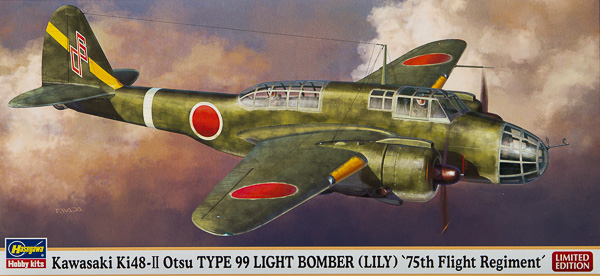
Hasegawa 1/72 Kawasaki Ki-48-II Otsu Type 99 Light Bomber (Lily) "75th Flight Regiment"
By Chris Banyai-Riepl
Overview
In 1937, the Japanese leadership went looking for a high-speed bomber. Kawasaki received the order and, inspired by the Tupolev SB, developed the Ki-48. Kawasaki's experience with the Ki-45 twin-engined heavy fighter helped, but the Ki-48 was quickly overshadowed by fighter development that left the plane vulnerable. Still, the Ki-48 remained in operational service throughout the war, and even operated post war in China and Indonesia.
The Kit
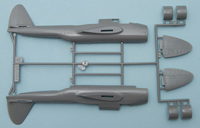 When one thinks of Hasegawa, one thinks of modern new-tool kits with finely recessed panel lines, accurate shape, and well researched markings. Their 1/72 Ki-48 kit is all of that, except for the first part. It is accurate in shape, features finely recessed panel lines, and has well researched markings, but it is actually a very old kit. The molds originated with Mania back in the early 1970s, which is very impressive given that this kit looks every bit like a current new-tool model. Molded in the typical Hasegawa light gray plastic, the kit comes with a decent interior, cowling options, markings for three aircraft, and in this Limited Edition, new photoetch detail parts.
When one thinks of Hasegawa, one thinks of modern new-tool kits with finely recessed panel lines, accurate shape, and well researched markings. Their 1/72 Ki-48 kit is all of that, except for the first part. It is accurate in shape, features finely recessed panel lines, and has well researched markings, but it is actually a very old kit. The molds originated with Mania back in the early 1970s, which is very impressive given that this kit looks every bit like a current new-tool model. Molded in the typical Hasegawa light gray plastic, the kit comes with a decent interior, cowling options, markings for three aircraft, and in this Limited Edition, new photoetch detail parts.
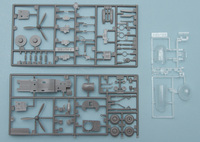 Construction begins with the interior, and here you get a one-piece floor that gets separate seats, sidewalls, front bulkhead, and various other detail bits. With some careful painting this will look pretty good, but the more detail oriented might want to track down a photoetch detail set to add that extra little bit. The completed cockpit gets sandwiched between the fuselage halves, and from here on out the assembly goes quite fast.
Construction begins with the interior, and here you get a one-piece floor that gets separate seats, sidewalls, front bulkhead, and various other detail bits. With some careful painting this will look pretty good, but the more detail oriented might want to track down a photoetch detail set to add that extra little bit. The completed cockpit gets sandwiched between the fuselage halves, and from here on out the assembly goes quite fast.
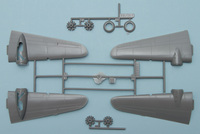 The wings are split into upper and lower halves, with separate cowlings. There are two options provided for those cowlings, depending on the variant you choose to build. The engines feature both rows of cylinders and mount to separate firewalls. The stabilizers are solid pieces, and the propellers are molded integrally with their spinners. The photoetch parts are also for the wings, and provide the dive brakes on the underside. They also provide bracing struts for the stabilizers found on one of the marking choices. The last step is to add the landing gear, which has separate struts, actuators, and split wheels. Mask the canopy and break out the paint, as you're ready to color your Ki-48.
The wings are split into upper and lower halves, with separate cowlings. There are two options provided for those cowlings, depending on the variant you choose to build. The engines feature both rows of cylinders and mount to separate firewalls. The stabilizers are solid pieces, and the propellers are molded integrally with their spinners. The photoetch parts are also for the wings, and provide the dive brakes on the underside. They also provide bracing struts for the stabilizers found on one of the marking choices. The last step is to add the landing gear, which has separate struts, actuators, and split wheels. Mask the canopy and break out the paint, as you're ready to color your Ki-48.
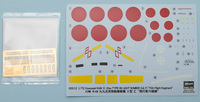 The three color schemes are quite varied, ranging from simple overall gray to complex camouflage. Starting with the simple, this is a plane from the Hokota Flying School and it is finished in overall gray. Next up in complexity is the boxtop aircraft, a Ki-48-II from the 75th Flight Regiment, 3rd Company, in Indonesia in 1944. This plane is finished in gray with green upper surface camouflage. The third choice is also from the 75th Flight Regiment, but from the 1st Company on the Malay Peninsula in 1942. This aircraft features a more disruptive camouflage of green blotches over the gray. All three are interesting options.
The three color schemes are quite varied, ranging from simple overall gray to complex camouflage. Starting with the simple, this is a plane from the Hokota Flying School and it is finished in overall gray. Next up in complexity is the boxtop aircraft, a Ki-48-II from the 75th Flight Regiment, 3rd Company, in Indonesia in 1944. This plane is finished in gray with green upper surface camouflage. The third choice is also from the 75th Flight Regiment, but from the 1st Company on the Malay Peninsula in 1942. This aircraft features a more disruptive camouflage of green blotches over the gray. All three are interesting options.
Conclusion
It is always welcome to see Hasegawa re-release some of their classic kits, and this is definitely in that category. While a very old kit, it is also a very good kit, especially for its age, and I would not hesitate to pick one up again. My thanks to Hasegawa USA for the review sample.
